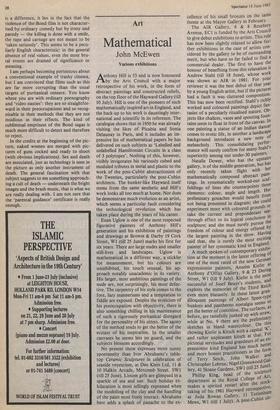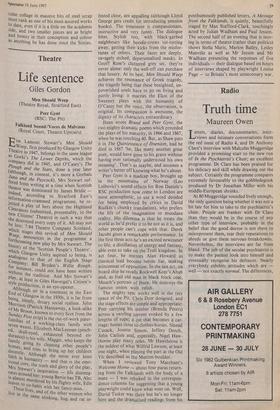Art
Mathematical
John McEwen
Various exhibitions
Anthony Hill is 53 and is now honoured by the Arts Council with a major retrospective of his work, in the form of abstract paintings and constructed reliefs, on the top floor of the Hayward Gallery (till
10 July). Hill is one of the pioneers of such mathematically inspired art in England, and the back-up to his work is dauntingly inter- national and scientific in its reference. The catalogue shows that in 1950 he was already visiting the likes of Picabia and Sonia Delaunay in Paris, and it includes an im- pressive list of mathematical papers he has delivered on such subjects as 'Labelled and unlabelled Hamiltonian Circuits in a class of 3 polytopes'. Nothing of this, however, visibly invigorates his variously cubed and moduled tributes in metal and plastic to the work of the post-Cubist abstractionists of the Twenties, particularly the post-Cubist architects. The bunker-like Hayward itself stems from the same aesthetic and Hill's work looks all too much at home. Nor does he demonstrate much evolution as an artist, which seems a particular fault considering the technological revolution which has taken place during the years of his career.
Euan Uglow is one of the most respected figurative painters of Anthony Hill's generation and his exhibition of paintings and drawings at Browse & Darby 19 Cork Street, WI (till 25 June) marks his first for six years. There are large nudes and smaller still-lives and landscapes. Uglow is mathematical in a different way, a stickler for measurement, but his colours are uninhibited, his touch sensual, his ap- proach notably unacademic in its variety. His larger, most ambitious paintings of the nude are, not surprisingly, his most defec- tive. The carpentry of his style comes to the fore, lazy mannerisms and a temptation to fiddle are exposed. Despite the eroticism of his preoccupation with objectivity, there is also something chilling in his maintenance of such a rigorously puritanical disregard for the personality of his sitters. The agony of the method tends to get the better of the ecstasy of his inspiration. In the smaller canvases he seems less on guard, and the subjects blossom accordingly.
No present show expresses more sunny spontaneity than Ivor Abrahams's table- top Ceramic Sculptures in celebration of seaside voyeurism, at Dan Klein Ltd, 11 & 10 Halkin Arcade, Motcomb Street, SW1
(till 25 June). Lissom girls are glimpsed in a sparkle of sea and sun. Such holiday ex- hilaration is most tellingly expressed when the modelling of the clay and the handling of the paint most freely interact. Abrahams here adds a splash of panache to the ex-
cellence of his small bronzes on the same theme at the Mayor Gallery in February. The AIR Gallery, 6 & 8 RoseberY Avenue, ECI is funded by the Arts Council to give debut exhibitions to artists. This rule has now been slightly relaxed to allow fur- ther exhibitions in the case of artists con- sidered by the gallery to be of outstanding merit, but who have so far failed to find a commercial dealer. The first to have the honour of benefiting from this relaxation is Andrew Stahl (till 18 June), whose work was shown at AIR in 1981. For your reviewer it was the best debut of that year by a young English artist, but if the pictures had a fault it was cluttered composition. This has now been rectified. Stahl's richly worked and coloured paintings depict fan- tasies of a peculiarly ritualised nature. Ob- jects like chalices, vases and spouting foun- tains seem to float in front of the canvas. In one painting a statue of an Indian dancer comes to erotic life, in another a landscape background introduces a new note of melancholy. This consolidating perfor- mance will surely confirm for many Stahl's superiority among our under-30 painters. Natalie Dower, who has the upstairs gallery, is of the middle generation, but has only recently taken flight with her mathematically composed abstract Pain- tings. In systematically worked-out scaf- foldings of lines she counterpoints three elements: colour, angle and length. Her preliminary gouaches would benefit from not being presented in diagram; she could experiment more with coloured grounds or take the current and preponderant see- through effect to its logical conclusion in sculpture; and she must surely pursue the freedom of colour and energy offered .by the largest painting in the show. Having said that, she is surely the most exciting painter of her systematic kind in England. A much spoken-of contemporary exhibi- tion at the moment is the latest offering of one of the most rated of the new German expressionist painters, Anselm Kiefer. at Anthony d'Offay Gallery, 9 & 23 DerIng Street, WI (till 9 July). Kiefer is the most successful of Josef Beuys's students, an. d exploits the memories of the Third Reich even more blatantly. In these latest gran- diloquent paintings of Albert Speer-tYPe bunkers and pantheons nostalgia seems to get the better of contrition. The surfaces, as before, are tastefully junked up with straw, while at No. 9 there are the preliminary sketches in bland watercolour. On this showing Kiefer is Kitsch with a capital `1( and rather unpleasant kitsch at that. For pictorial servitudes and grandeurs of an ex- pressionist kind England has much better and more honest practitioners in the form of Terry Setch, John Walker and Christopher Lebrun; Nigel Greenwood Gal- lery, 41 Sloane Gardens, SW1 (till 25 Jun). Phillip King, head of the sculpture department at the Royal College of Art, makes a spirited restart after the ecstock- taking of his 1981 Hayward retrosptive, at Juda Rowan Gallery, 11 Tottenham Mews, WI (till 1 July). A post-Cubist cir-
cular collage in massive bits of steel scrap must rank as one of his most assured works to date, even if it is a little on the academic side, and two smaller pieces are as bright and breezy in their conception and colour as anything he has done since the Sixties.







































 Previous page
Previous page